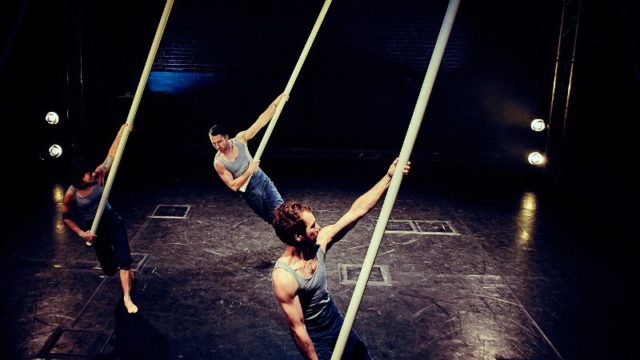This response was produced as part of the #CircusVoices scheme for developing critical languages around circus arts.

Ockham’s Razor have been at the forefront of aerial circus theatre for over 10 years. Originality and inventiveness are the defining characteristics of their work. The company seek to explore and reinvent how a circus show is constructed, how the apparatus is formed and used, and how the performers interact with the space and with each other.
The group takes its name from a medieval principal of logic, attributed to the philosopher William of Ockham, which states that between two plausible theories, the simpler is preferable. It is called a razor because it cuts out unnecessary elements. The company works with this idea at its heart and the principal of simplicity is clear in the raw, uncluttered work that they produce, which cuts back to the essentials of physical theatre: bodies within a space.

Tipping Point is a perfect example of how experimentation and innovation in circus can produce surprisingly powerful moments that, when shared with the audience, can provide them with a new way of understanding what circus can be.
Often in modern circus, we still see traces of the traditional circus format where shows are made up of individual acts of different disciplines and then broken up by smaller performances from characters such as the ringmaster or clown, who fill the pauses between acts. This format can be traced right back to the birth of circus in the 1700s when Philip Astley (commonly credited as the inventor of circus as we think of it today) hired acrobats, jugglers and other performers to fill the gaps between the equestrian acts which, at that time, made up the bulk of his show.
Contemporary circus developments have produced shows that try to move away from this format and often use a running narrative throughout, with acts being used as a means of communicating their story to the audience rather than just as a display of technical skill.

In Tipping Point, even that narrative is left on the back burner… it is not the essential element of the show. That is not to say that we don’t see hints and snippets of underlying meaning breaking through at moments. We are impelled to reflect on the importance of trust and of being supported by those closet to us, to analyse our relationships and to consider how we approach the challenges and achievements of life, thanks to the meditative, calming atmosphere that the company create during the hour-long performance. However, these feel more like a by-product of the real epicentre of Tipping Point that, in my mind, is a question. That question is: what are the physical possibilities of performance in a 3-Dimensional space. The show is a collection of different responses to this question. It explores movement in every dimension and experiments with how the body and equipment can be manipulated and work around each other within a performance space.
The research has produced a show that has a hypnotic element, leaving the audience in a trance-like state as beams and bodies dance through the air before them. The performers work together as a unit. Although their personalities come through in little moments of interaction with each other and with the audience, their individual identity seems less important than the overall energy of the show. The focus moves away from distinct acts or tricks and instead becomes a series of tableaux which flow into one another to create a journey and style. However these little hints of individuality, a breath, a subtle smile, a hint of an ongoing game, are used expertly relieve tension, allowing the audience to recover after the intense concentration of watching the tableaux.

Perhaps the most impressive thing about Tipping Point is how directors Charlotte Mooney and Tina Koch – along with the performers Alex Harvey, (who co-founded the company with Koch and Mooney), Nich Galzin, Emily Nicholl, Telma Pinto and Steve Ryan – have invented new apparatus and new ways of using existing equipment. The show seems to have been born from an intense curiosity and desire to bring something new to the circus table. Ockham’s Razor have taken the Chinese Pole, a well-known piece of equipment that already has pre-defined rules, moves and techniques, and turned all of that on its head by make something new out of something old. They reinvent how equipment is used, how it’s rigged, how it moves and how the performer can move around it. The result is an original, surprising and aesthetically entrancing piece of work which brings innovation to the field of circus and which pushes forward the boundaries of possibility in aerial circus theatre.
I’m going to finish with something of a personal note. Shows like Tipping Point are the reason I continue to go and see circus and aerial theatre shows. Having seen a fair few shows of this genre, I buy tickets for each new production in the hope that they are going to present me with something I have never seen before, something that touches me and that challenges my understanding of what circus can be. Tipping Point fulfilled all of these criteria and I was enchanted from beginning to end so thank you Ockham’s Razor! If you are looking for a refreshingly original, intelligent and aesthetically stimulating piece of circus theatre, this is the show for you.
Ockham’s Razor’s Tipping Point is showing at C Scala at the Edinburgh Fringe until the 25th of August and will be touring the UK later this year.
.




